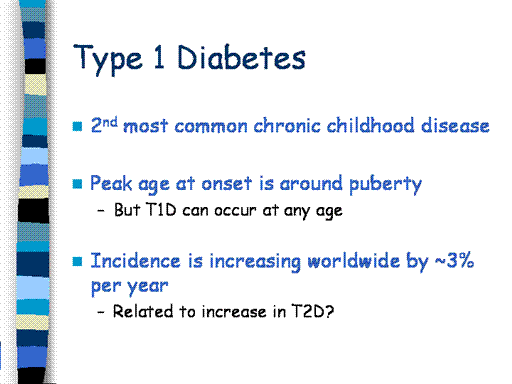| front |1 |2 |3 |4 |5 |6 |7 |8 |9 |10 |11 |12 |13 |14 |15 |16 |17 |18 |19 |20 |21 |22 |23 |24 |25 |26 |27 |28 |29 |30 |31 |32 |33 |34 |35 |36 |37 |38 |39 |40 |41 |42 |43 |44 |45 |46 |47 |48 |49 |50 |51 |52 |53| 54 |review |
 |
T1D is the
second most common chronic childhood disease.
The only disease with a higher prevalence in children is asthma.
It has been estimated that approximately 20 million people
worldwide have T1D.
The peak age
at onset of T1D is around the time of puberty, and generally occurs
earlier in girls than in boys. Although T1D is generally diagnosed in
children and young adults, it can occur at any age.
More is known about the epidemiology of diabetes in children
compared to adults because it has been easier to identify and study
affected children (e.g., ascertained through pediatricians) than
affected adults, who are treated by a variety of medical specialists,
including primary care physicians, endocrinologists, out patient
clinics, etc.
The incidence
of T1D is increasing around the world at a rate of about 3% per year,
reasons for which are currently unknown.
This trend appears to be most dramatic in the youngest age
groups, and is completely unrelated to the current increase in T2D in
children. Researchers have
speculated about possible environmental changes (e.g., air pollution,
improved hygiene, infant feeding patterns) that may explain the rising
incidence. These increasing T1D
incidence is unlikely to be due to genetic changes, because it takes
many generations to alter population gene frequencies.
Additional re\search is needed to determine why the incidence of
autoimmune T1D is increasing worldwide.
|